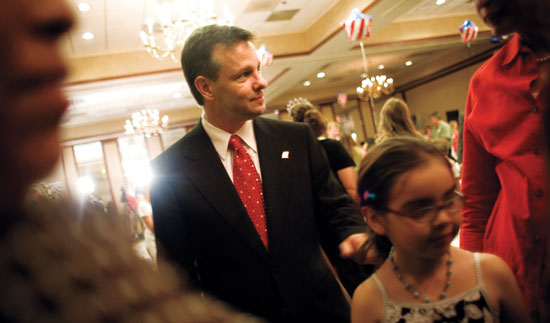There’s a booby trap waiting for anyone who steps into the discussion about illegal immigration. Even for those who step gingerly, hoping to proceed with balance, reason. It is into this very trap that I head on an election Saturday in early May, to hang out in Farmers Branch with Tim O’Hare, the Man Who Would Be Mayor.
The last time I saw O’Hare was in the fall of 2006, when we met in his stunningly immaculate house (what kind of bachelor lives like that?). Farmers Branch was at the center of a national debate, thanks to his efforts. As a freshman city councilman, O’Hare had proposed an ordinance to make English the city’s official language and ban illegal immigrants from working or renting in the town he’d called home all his life. The local media in general were ready to paint Farmers Branch as a hillbilly town and O’Hare as a man hiding white robes under a white collar.
Prior to the hubbub, I hadn’t given much thought to illegal immigration. But a lot of what the restrictionists were saying made sense. With six of 10 babies born at Parkland Hospital having undocumented parents and many of Dallas ISD’s ongoing woes attributable to what even my more liberal-minded friends dubbed “the immigrant problem,” it was hard not to drift toward the ground Lou Dobbs had staked out. There’s an attraction to the simplicity of the bumper-sticker question “What part of illegal don’t you understand?”
So when I met O’Hare in 2006, ours was the first friendly interview he’d conducted on the topic. But even then he seemed wary. And who could blame him? A Dallas Morning News columnist had erected a straw man in his image and set it alight not once but twice. Despite an outpouring of support from his neighbors, most everywhere else O’Hare turned, he was treated like the second coming of the poor painter from Austria. After an hour of talking with him, I came away liking the guy and agreeing with him in general, even if the topic of illegal immigration didn’t get me too worked up. I live in the safe, very white northern burbs, so it didn’t affect me on a daily basis.
A year and a half later, and not much has changed for O’Hare in the way the media treats him. His quiet intensity and his refusal to engage his critics at their level have led some to believe the man is more dangerous than ever. Then there was the support he’d gotten from the voters in Farmers Branch. His side was outspent seven to one, yet the referendum on renting to illegal immigrants passed in 2007 by a whopping 67 percent. If anything, the landslide made him less popular in the press.
A lot has changed for me, though. I’m still not passionate about illegal immigration, but I’ve turned a corner on the issue. I watched Katrina refugees—there’s no other word for it—whine two years after the storm about how they still needed handouts and free housing. Meanwhile people who couldn’t speak English and who may have come here stuffed in a trunk are out working by sunup. Sure, illegal immigrants burden social services, but it’s not like taxes would go down if those illegals were magically deported tomorrow. May as well enjoy getting your house built, lawn cut, and fruit picked at a discount. And a recent study shows that immigrant assimilation is happening faster now than it did 100 years ago when the bulk of the immigrants spoke English and looked like every other Mayflower descendent. Two-thirds of third-generation immigrants speak English only. But, again, easy for me to say, up in the Wonder Bread world of West Plano.
When I catch up with candidate O’Hare outside the polling location at the Farmers Branch Manske Public Library, he is battling the 90-degree heat in his navy blazer, smiling and shaking hands and asking for the support of every person he can. It was expected to be the highest turnout for a mayoral election in Farmers Branch history. Oddly, the topic of illegal immigration doesn’t come up much, no matter how much I poke and prod. If it is possible, O’Hare seems even more guarded than the last time we talked.
He approaches one prospective voter with his hand out and is begged off with a “No habla ingles.” O’Hare supporters and those backing his opponent, real estate agent Gene Bledsoe, take turns shooting ugly stares at each other. Federal election monitors chase after every voter who ends up at the wrong polling place. And O’Hare demonstrates his wicked sense of justice.
Word comes to him that a NBC Channel 5 cameraman was rude to an elderly couple in the parking lot. O’Hare says, “Watch this.” He stands by the library’s brick wall as the cameraman schleps his heavy camera and tripod across the street. He waits patiently while the tripod is set up in just the right spot and the camera is mounted and focused. And then O’Hare walks back across the street from whence the cameraman came to talk to some supporters. The cameraman follows, and O’Hare plays it out again, walking back to the library corner, a devious grin plastered on his face the whole time.
But the issue that put this election on the radar doesn’t really come up on election day—not openly, anyway. Illegal immigration wasn’t a pillar of O’Hare’s stump speech, wasn’t mentioned at all in his campaign materials, until a couple lines near the bottom of his last mailer. He says it’s old news. There are only two words he cares about now, he says. They’re the focus of someone who has seen his hometown fall into underachievement, vacant storefronts, and multifamily housing well past its use-by date.






